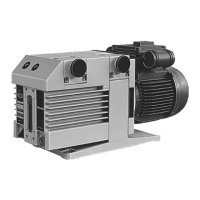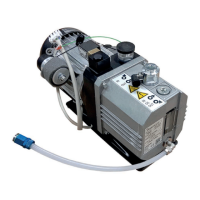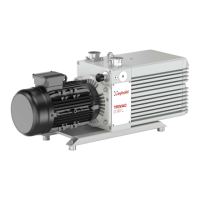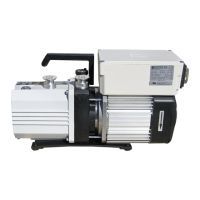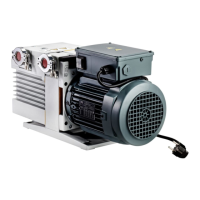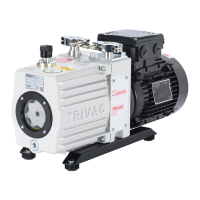11
"
(
,--
\
\
\
51
\
I
EXHAUST HOLES
lTA·S.l
NOTE: This photograph
is
for
illustration
purposes
only.
When
assembled,
the cap
end
of
the
gas
ballast
valve
(17)
is
attached outside the
top
of
the oil
casing
(12)
(see
Figure 1·1),
and
an
oil
filter
(35)
and
other parts
fit
around the
valve
(17) stem
(see
Figure 5·10B).
Figure 2-3.
Gas
Ballast Valve
and
Second
Stage
Pump Cylinder With Front End
Plate
Removed
2-3-2 Purpose and Function
of
the
Gas
Ballast Valve
6
All systems contain moisture. Some processes have large quantities of condensable vapors
in
the process gas.
When these vapors condense
in
the pump, they degrade the lubricating and sealing qualities of the pump fluid
(see Section 2-4) resulting
in
excessive pump wear, higher base pressure, and sometimes pump seizure.
The gas
ballast valve allows removal
of
condensable vapors and condensate such as water, alcohol, gasoline.
benzene, carbon tetrachloride, etc.
from
the pump. It also enables high levels
of
water vapors
to
be pumped
without
condensation. The water vapor tolerance
for
your
pump is listed in
Table4-1.
If the partial pressure
of
water vapor in the gas being pumped exceeds the tolerance
of
your
pump, the vapor
will
condense.
We
recommend installing an
AK
condensate trap on the pump when pumping saturated vapors (see Section 1
of
our catalog
for
more
information
on condensate traps).
(
When the gas ballast valve (17) is open, it admits a controlled amount of air into the second stage pump cylinder
(46)
just before the exhaust holes (see Figure
2-3).
The open gas ballast valve prevents vapors from condensing
by reducing the
partial pressure of the condensable vapors and by increasing the operating temperature of the
pump.
The gas
ballast valve is not fully effective until the pump is warm to the touch. When using the gas ballast valve
to remove condensate from the pump fluid, it is best to seal off the intake tube
(1).
Sealing off the intake tube
(1)
prevents additional vapors from entering the pump while the condensate is being vaporized and the vapor is
being ejected.
See Sections 4-1-2 and
4-2
for instructions for using the gas ballast valve during start-up and operation.
In addition to increasing the operating temperature, running the pump with the gas ballast valve open also results
in
higher ultimate pressure (see Table 4-1), higher pump fluid consumption, and a pump fluid mist
in
the exhaust
stream.
If you run the pump with the gas ballast valve open continuously,
we
recommend
an
SE
smoke eliminator
or
an
AF exhaust filter with
an
oil return line. After closing the gas ballast valve the pump normally reaches ultimate •
pressure as soon as it cools to operating temperature. •
TRIVAC
"A"
Manual,
Edition L
